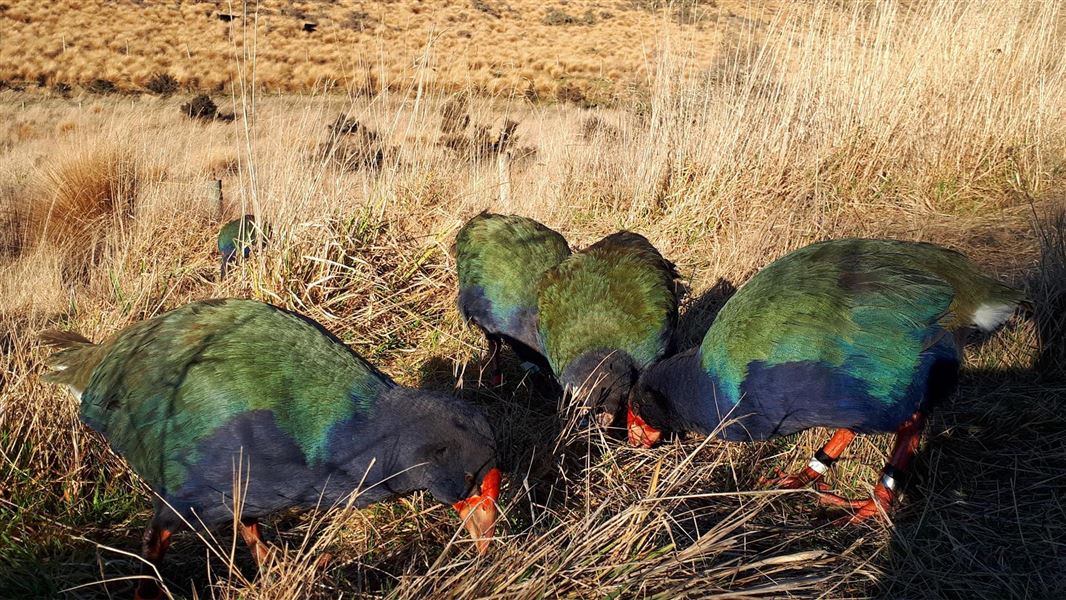Archived content: This media release was accurate on the date of publication.
Date: 11 August 2022
This is one of the largest cohorts to leave Mana Island in one year, as COVID-19 disruptions only allowed a single takahē to be transferred last year.
Transfers keep genetics strong in the population and bolster numbers at our recovery sites. All this work is growing the total population, now approaching a landmark 500 adult birds.
Four of the takahē (Ru, Wai, Kahua, and Riki) are juveniles that hatched on Mana Island last spring, named by representatives of Ngāti Toa Rangitira. They are getting big now and their beaks are turning from incognito-grey to red.
Another two (Heke and Tahu) are sub-adults that hatched in the 2020/21 season. They have spent an extra year hanging out with their parents, helping raise their younger siblings.
There will also be another individual (Hōri) departing later in August to be paired with a young female from the Burwood Takahē Centre. Together they will be sent to Wairakei as a future breeding pair.
Takahē Sanctuary Sites Ranger Phil Marsh says this cohort is the culmination of several years’ work to improve the genetic stock on Mana Island.
“These young takahē are all going to the Burwood Takahē Centre near Te Anau, where they will learn how to eat tussock and hypolepis with the big kids. Young birds are paired with older ‘tutors’ who show them how to forage for these delicacies.
“Once complete, this transfer will ensure that our sites have the best genetics present for continued diversity and healthy bloodlines.”
The birds were encouraged into pens with pellets, caught, weighed, vaccinated, and sent on their way in custom takahē travel boxes.
They were farewelled from Mana Island with a karakia by Ngāti Toa Rangatira Kaumatua Hohepa Potini, accompanied by representatives from the iwi-led Jobs for Nature project Ngā Pari e Rua.
To keep Mana Island at the ideal carrying capacity of about eight breeding pairs, three new takahē will travel to the island in August. Wiggins and Oberon will make the reverse journey from Southland, and Franklin will replace Hōri.
Background information
Takahē are a taonga of Ngāi Tahu. After being presumed extinct for nearly 50 years, takahē were famously rediscovered in 1948.
Geoffrey Orbell, a physician from Invercargill, and his party found the last remaining wild population of the bird high in the tussock grasslands of the remote Murchison Mountains, above Lake Te Anau in Fiordland.
The rediscovery of takahē launched New Zealand’s longest running endangered species programme. For more than 70 years, measures to ensure takahē are never again considered extinct have included pioneering conservation techniques for endangered species, captive breeding, island translocations and wild releases.
DOC's dedicated Takahē Recovery Programme is working hard to grow the number of Takahē and establish self-sustaining wild populations within their former range – the native grasslands of the South Island. Fulton Hogan is a partner to the programme.
Takahē only breed once a year, raising one to two chicks. Pairs will fiercely defend their territories. Families need a lot of space, with territories ranging between 15–40 ha, depending on the availability and quality of their food.
They once roamed across the South Island, but pressures from hunting, introduced predators, habitat destruction and competition for food led to their decline.
Contact
For media enquiries contact:
Email: media@doc.govt.nz
